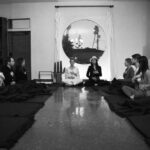When the mind is agitated, change the pattern of the breath. /Patanjali
Can it be that easy?
Learning breathwork is for all. If you are alive, you breathe. If you breathe you can learn to use your breath as a tool for soothing, nurturing, enhancing, surmounting and transforming your state of well-being. It is no wonder the practice has been growing steadily in popularity. There are bestselling books, apps, guided practices on Zoom and IGlive—and every well-rounded physical movement class now incorporates exercises focused on the expansion and control of the breath.
But what is breathwork as a stand-alone method?
If you’re one of the curious and have taken the dive down the internet-hole, you will have likely learned there are a myriad of techniques that teach us to engage and expand the breath—there is Performative, Holotropic, Ecstatic, Transformational, Bioenergetic, Shamanic, Alkaline, and Rebirthing breathing just to name a few—how easy to run out of (excuse the pun) breath before even beginning. Yet the different styles and schools have more in common than their divergent names suggest. The message remains the same: the breath is the key to the mind and the portal to the heart.
To illuminate ways on how to proceed further, we compiled a guide to the brightest lights within the galaxy of the varied conscious-breathing and breath-awareness techniques most commonly practiced today. These teachers and holders of sacred space nurture the knowledge of the ancients while forming the breathwork landscape of the present and what shall come tomorrow.
We asked questions on love, devotion, grief, their associations with the color green, and their connection to the element of air—returning always to the most essential in life: the breath and the heart.








